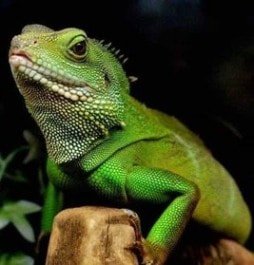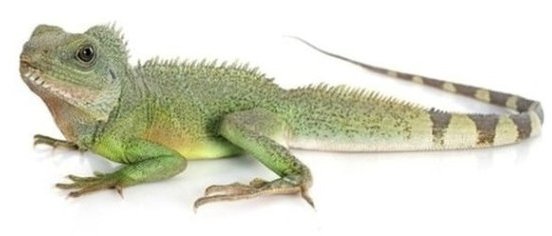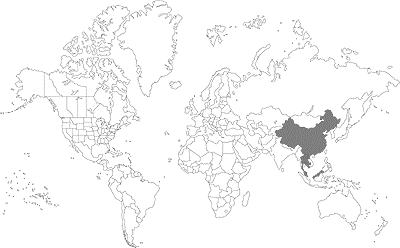Chinese Water DragonPhysignathus cocincinus |

Custom Search
|
The Chinese water dragon is native to the lowland and highland forests of southern China and East and Southeastern Asia including Vietnam, Laos, Thailand, Cambodia, and Burma.
They inhabit semi-aquatic freshwater environments and are commonly found along the banks of freshwater lakes, rivers, and streams. These areas have average temperatures ranging from 80 to 90 °F (26–32 °C) and humidity levels of 40 to 80%. These medium sized lizards can grow up to 3.3 ft (1m) in length, including the long tail, but in most cases, they reach only 2 to 2.6 ft (60 to 80 cm) long, with males being usually larger than females. The tail comprises just over 2/3 of the Chinese water dragon total length and can be used for balance, assist swimming or as a weapon. Their body and most notably the tail are laterally compressed which enables them to easily swim in water. It has also a very noticeable spiky crest on the back and neck. The back ranges from a vivid light green to a dark green however it can also sometimes be purple or even dark brown. The body has green, cream or turquoise diagonal stripes. The belly color ranges from white, very pale green or pale yellow to orange, with the throat and the chest being yellow to orange. There are some nuances of blue and pink around the big round scales in the throat region and very often a yellowish coloring is present along the flanks. The tail is banded from the middle to the end with green and white or dark brownish-green to brown, these bands become larger towards the end of the tail.

Chinese water dragons like numerous other reptiles features one small, iridescent, photosensitive spot between their eyes known as the pineal or parietal eye, often referred to as "the third eye".
It's thought it is used to help thermoregulate their body temperature by sensing variations in light. They are diurnal reptiles, being most active during the day, they are also arboreal spending their time in plants and trees, usually located close to water. If feeling threatened, they will drop from the trees into the water and may swim to safety or remain submerged for a period of up to 25 minutes. Sometimes they use their hind legs to run into the dense riparian undergrowth to escape. Large snakes and birds of prey are their primary predators. The Chinese water dragon is extremely popular as an exotic pet, thanks to their unique look and friendliness, making them suitable to those with little experience but also for more advanced herpetoculturists. Captive Chinese water dragons have an average lifespan between 10 and 15 years but with proper care, some can even reach 20 years. Subspecies / Taxonomy / Etymology The Chinese Water Dragon has no recognized subspecies but you can definitely find other very similar lizard species, like the Australian Water Dragon (Intellagama lesueurii) which is their closest genetic relative. The Chinese Water Dragon was first described as Physignathus cocincinus by Georges Cuvier a French naturalist and zoologist in 1829. Diet / Feeding The Chinese water dragon is omnivore by nature, eating just about anything it finds. They feed mainly on insects and other invertebrates. But despite that, they will sometimes eat vegetation, and occasionally small fish, birds, eggs as well as small mammals like rodents or even other reptiles. In captivity, they are fed a variety of insects such as king mealworms, crickets, silkworms, and waxworms, roaches, grasshoppers, and earthworms. Reproduction Both males and females establish territories, however male Chinese water dragons are incompatible. Traditionally they live in a small group consisting of one male and a few females. The male courtship rituals include pursuing females, head bobbing and prominent positioning, and when mating males bite into the female's crest. Females lay between 6 and 15 small eggs (about 2,5 cm long), with the temperature ranging from 25 to 31 °C the young hatch after a period of 60 to 75 days. The hatchlings measure about 1 inch (2.5cm) snout to vent but 5 to 6 inches (13-15 cm) in total length. There's no parental care for the young lizards who have to fend for themselves. Conservation status and main threats The Chinese water dragon has not yet been assessed for the IUCN Red List and isn't listed in CITES. Even though it's not considered endangered in the wild habitat destruction and the continued collection of wild specimens for the exotic pet trade does pose a threat to the species future survival. The Chinese water dragon is are getting more and more popular due to their inexpensive price when compared to iguanas, so many people import them from China or Indonesia.
|
Scientific classification
Kingdom: Animalia Phylum: Chordata Class: Reptilia Order: Squamata Family: Agamidae Genus: Physignathus Species: P. cocincinus |


